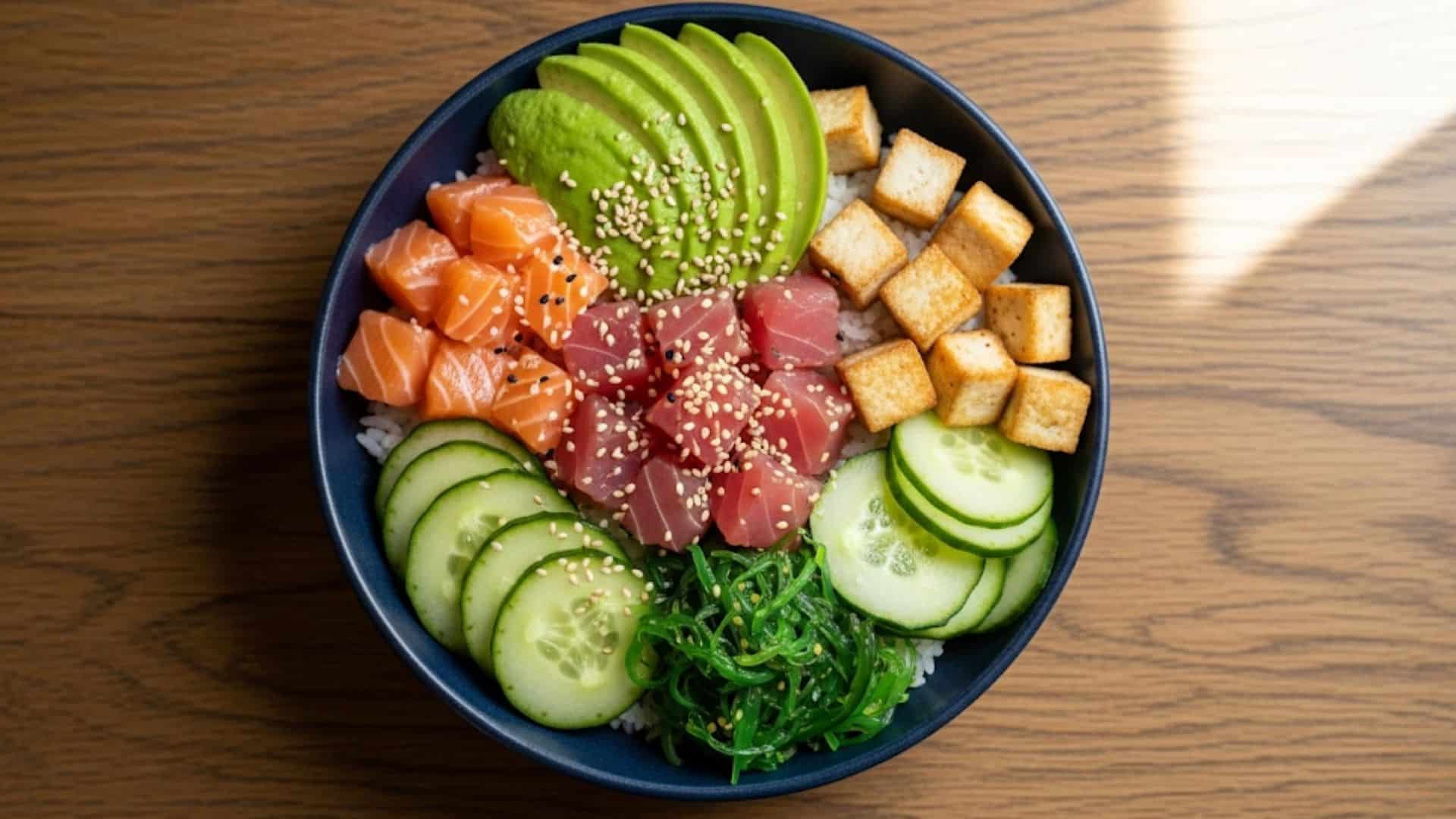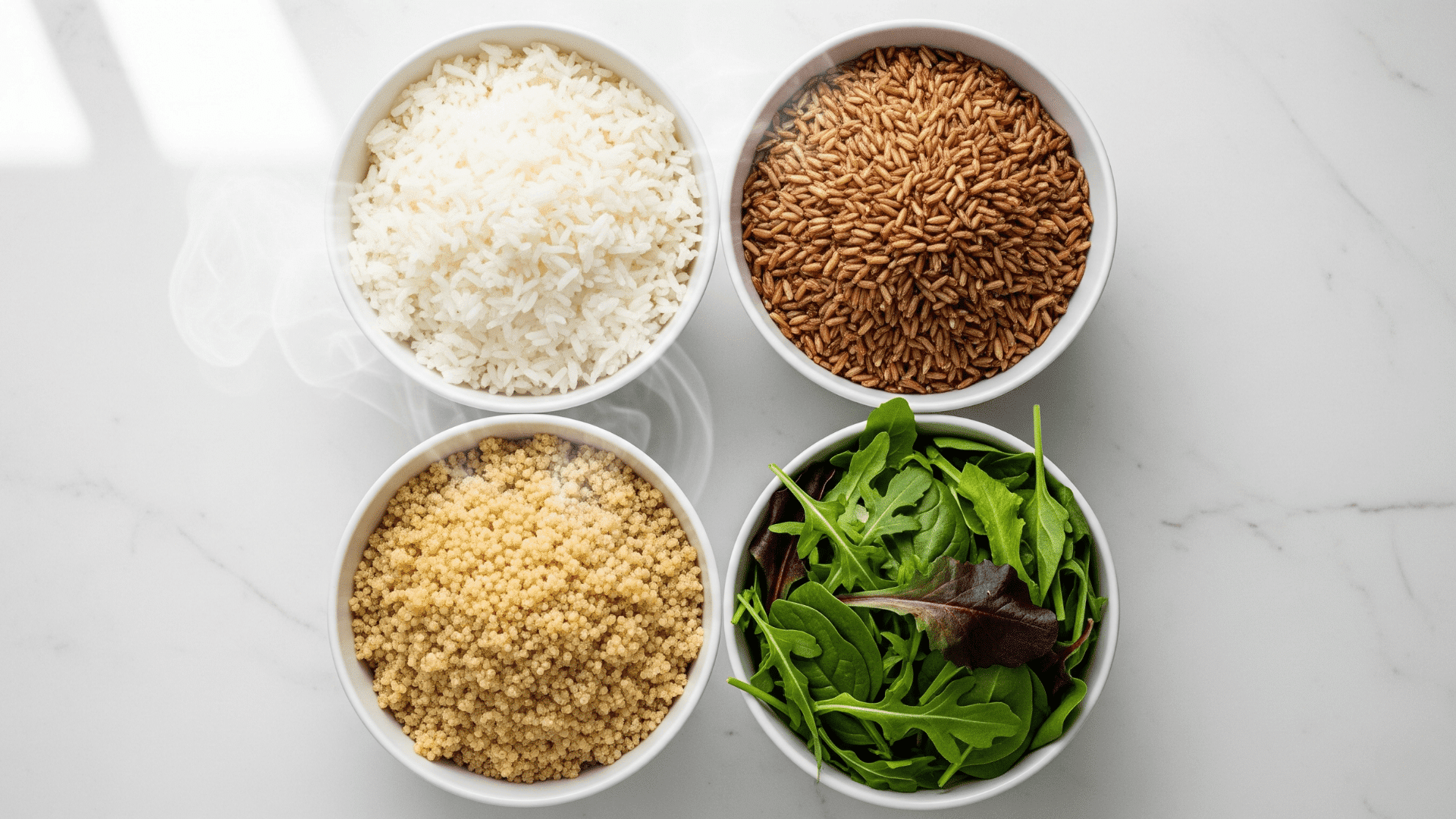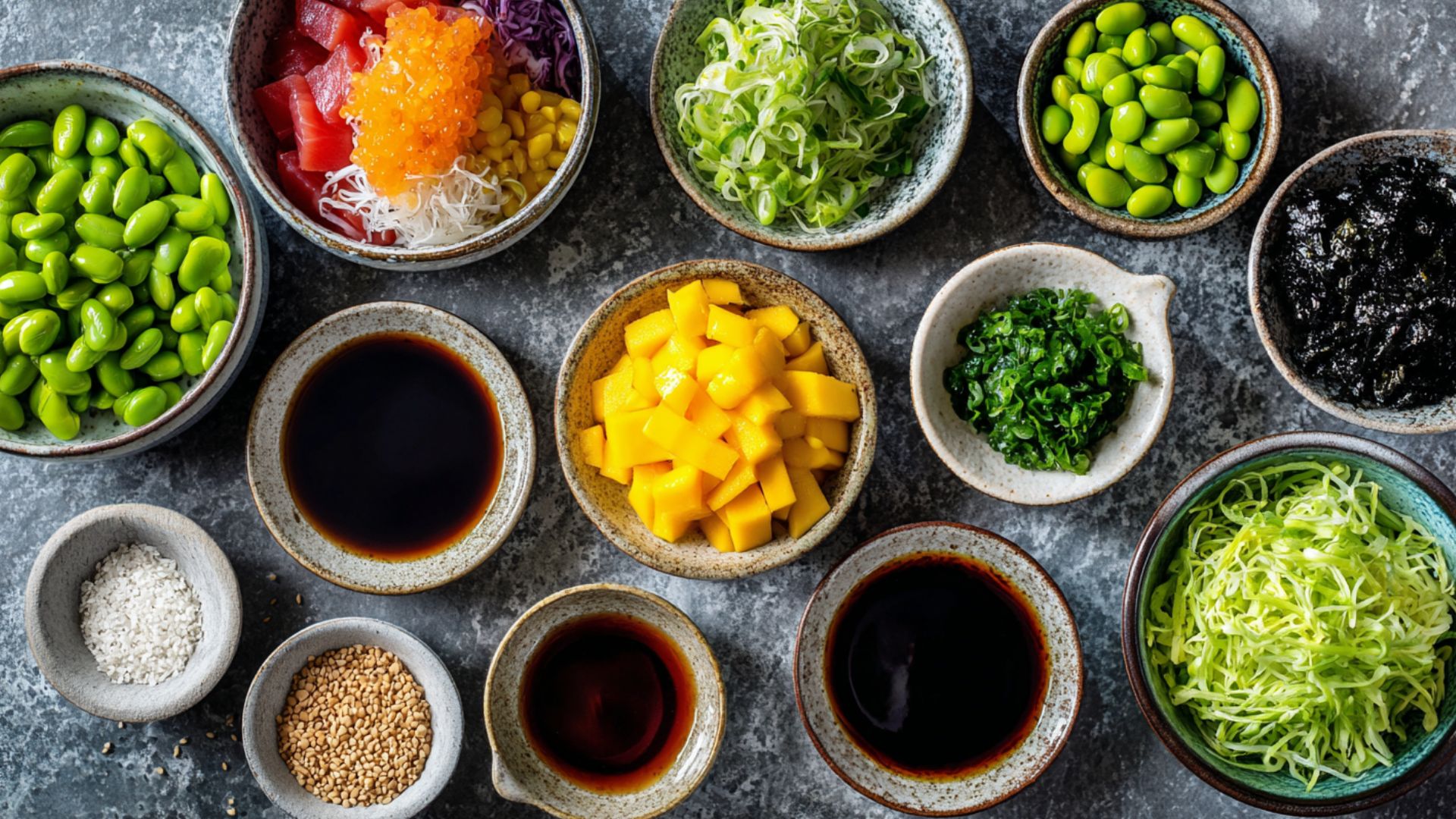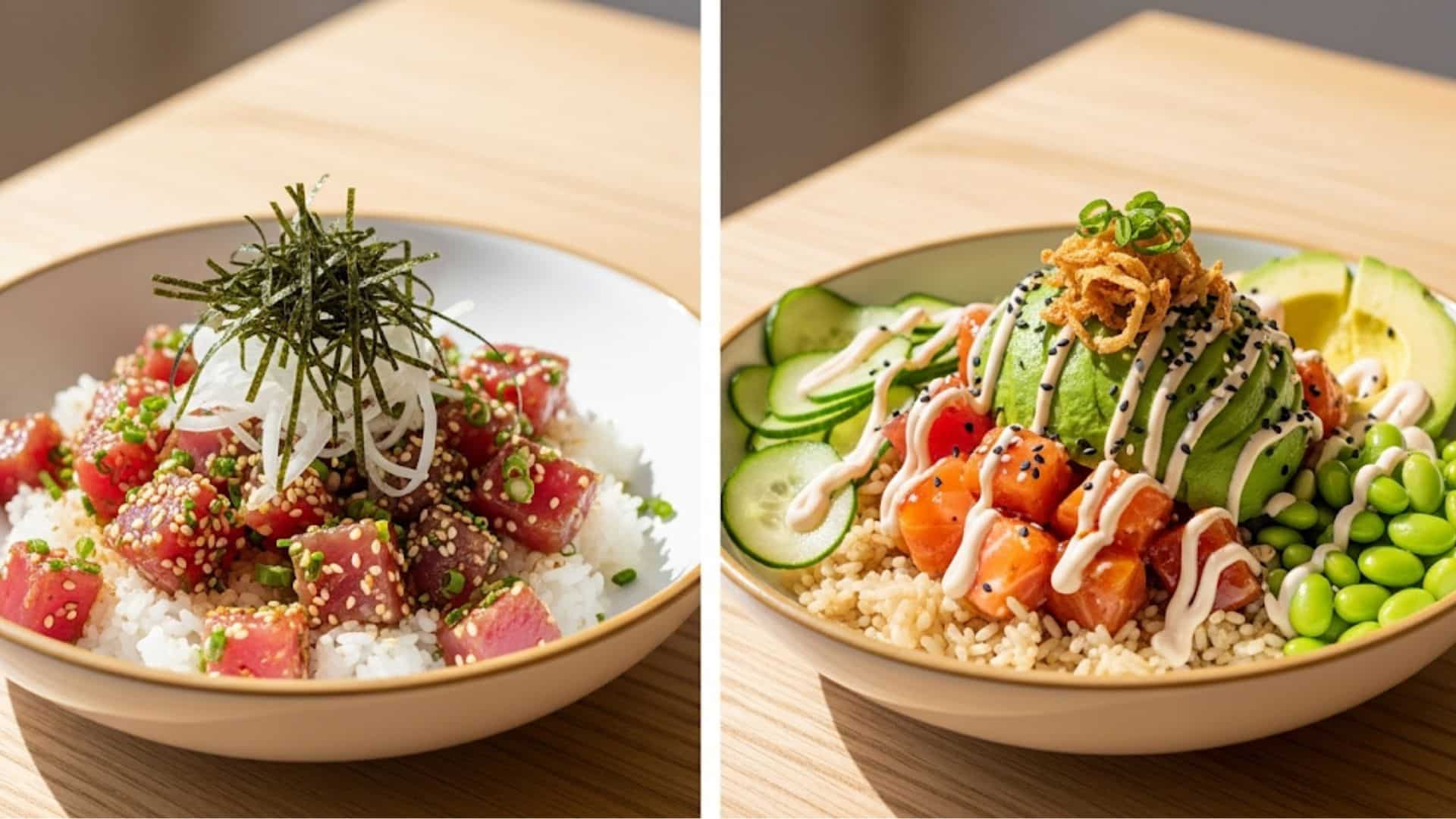Are you interested in what’s really inside that colorful poke bowl you love ordering for lunch? These bowls have deep origins in poke bowls in Hawaii, where fishermen created simple, fresh meals from their daily catch.
Understanding poke bowl nutrition facts helps you make smarter choices when eating out or preparing meals at home.
Modern versions can range from healthy powerhouses to calorie-heavy dishes, depending on your ingredient selections. You might be surprised by how much the protein, base, and toppings affect the total nutritional value.
Making informed decisions about your food doesn’t have to be complicated or stressful. Knowledge about poke bowl nutrition facts puts you in control of your health.
Why is Poke Bowl Considered Healthy?
Poke bowls are healthy because they provide high-quality protein from fresh fish like salmon or tuna. This protein helps build and repair muscles.
They are rich in omega-3 fatty acids, which support heart health and brain function. Poke bowls also include lots of vegetables, giving you fiber and important vitamins.
Antioxidants from seaweed, sesame seeds, and fresh produce help your body fight damage from daily stress.
Overall, poke bowls offer a balanced, nutrient-packed meal that feels fresh and energizing, making them a smart and tasty choice for anyone wanting to eat healthier without sacrificing flavor.
Average Poke Bowl Nutrition Facts

Poke bowls typically have between 500 and 900 calories, depending on the base, protein, and toppings chosen.
They provide a balanced mix of macronutrients, often including carbs from rice or noodles, protein from fish or tofu, and healthy fats from avocado or sesame seeds.
Sauces add flavor but can increase sodium and sugar content, so choosing them wisely helps keep meals healthier.
On average, sodium levels are moderately high due to soy-based sauces, and sugar comes mostly from sweetened sauces or dressings.
Overall, poke bowls provide a nutritious meal with protein, fiber, healthy fats, and essential minerals, while keeping calories manageable.
Breakdown by Key Ingredients
I’ve organized poke bowl ingredients into three main categories that impact your bowl’s nutritional value and taste. These breakdowns help you make informed choices about protein, base, and toppings to create a balanced meal:
1. Protein Choices

Protein forms the foundation of any nutritious poke bowl and provides essential amino acids for your body. These protein options offer different nutritional profiles to match your dietary preferences and health goals:
| Protein Type | Calories (per serving) | Protein (g) | Fat (g) | Carbs (g) | Sodium (mg) | Notes |
|---|---|---|---|---|---|---|
| Tuna | 475 | 36 | 16 | 47 | 278 | High protein, moderate fat, moderate carbs, moderate sodium |
| Salmon | 434 | 27 | 22 | 38 | 1492 | Rich in omega-3 fats, moderate protein, and higher sodium |
| Tofu (Vegan) | 425 | 20 | 18 | 52 | 1106 | Plant-based protein, moderate fat and carbs, moderate sodium |
| Shrimp | 559 | 18 | 47 | 18 | 834 | Higher fat, moderate protein, lower carbs, moderate sodium |
| Chicken | 639 | 40 | 17 | 63 | 2311 | High protein, higher carbs, moderate fat, high sodium |
Choose your protein based on your nutritional needs and taste preferences. Consider sodium content if you’re watching your salt intake for health reasons.
2. Base Options

The base you choose affects the overall nutritional value and satisfaction level of your poke bowl. Different grain and vegetable bases provide varying amounts of fiber, protein, and complex carbohydrates:
| Base Type | Calories (per 1 cup) | Protein (g) | Carbs (g) | Fiber (g) | Notes |
|---|---|---|---|---|---|
| White Rice | 205 | 2.7 | 28 | 0.6 | Higher in carbs, low fiber |
| Brown Rice | 215 | 2.7 | 23 | 3.1 | Good fiber source, moderate carbs |
| Quinoa | 120 | 4.4 | 21 | 5.2 | Higher protein and fiber |
| Salad Greens | 10-20 (varies) | 1-2 | 2-4 | 1-3 | Very low-calorie, nutrient-dense |
Brown rice and quinoa provide more nutrients and fiber than white rice. Salad greens keep calories low while adding vitamins and minerals to your meal.
3. Sauces and Toppings

Sauces and toppings add flavor and nutrients, but can significantly impact the total calories and sodium content. Choose wisely to enhance your bowl without overwhelming it with excess calories or salt:
| Sauce/Topping | Calories (per tbsp) | Sodium (mg) | Notes |
|---|---|---|---|
| Soy Sauce | 10 | 900+ | Very high in sodium, low calories |
| Spicy Mayo | 90-100 | 100-200 | High in calories and fat |
| Ponzu Sauce | 10-15 | 200-400 | Low calories, moderate sodium |
| Sesame Oil | 120 | Low | High calories from healthy fats |
| Avocado | 45 (per 1/4 fruit) | Low | Healthy fats, nutrient-rich |
| Edamame | 40-50 (per 1/4 cup) | Low | High protein and fiber |
| Seaweed | 5-10 (per tbsp) | Low | Rich in antioxidants and minerals |
| Mango | 20-25 (per 1/4 cup) | Low | Natural sugars, vitamins |
Use high-sodium sauces sparingly and opt for nutrient-dense toppings like avocado and edamame instead. These additions provide healthy fats, fiber, and essential vitamins without excessive calories.
Poke Bowl Nutrition by Style

Poke bowls vary in calories depending on style and ingredients. Traditional Hawaiian poke bowls mostly include raw fish, seaweed, light sauces, and rice.
These typically contain about 400 to 600 calories per serving and are lower in fat and sodium. Modern American or Japanese fusion poke bowls often add creamy sauces, rich toppings, or more carbs, pushing calories up to 700–900.
Popular restaurants like Pokeworks or Sweetfin use richer sauces, which add sugars and sodium. Homemade poke bowls let you control ingredients and keep calories lower, usually under 600.
Store-bought or restaurant versions can have more salt and fat, so careful choices make homemade the healthiest option for poke lovers.
Potential Downsides to Watch Out For
While poke bowls can be healthy, some ingredients and preparation methods create nutrition concerns. Being aware of these issues helps you make better choices when ordering or preparing your bowl:
- High sodium content from sauces like soy sauce and teriyaki can exceed the daily recommended limits.
- Creamy dressings and fried toppings like tempura add significant calories and unhealthy fats to your meal.
- Raw fish requires proper handling and freshness to prevent foodborne illness and stomach problems.
- Large portion sizes at some restaurants can lead to overeating and consuming too many calories.
These downsides don’t mean you should avoid poke bowls completely or feel guilty about enjoying them. Making smart ingredient choices and eating reasonable portions helps you reap the benefits while minimizing potential health issues.
Tips for Making a Healthier Poke Bowl
Simple swaps and smart choices can transform your poke bowl into a more nutritious meal. These changes help you enjoy all the flavors while supporting your health and energy goals:
- Choose brown rice, quinoa, or greens as your base for more fiber and nutrients.
- Pick lean proteins like tuna or salmon and load up on colorful vegetables for vitamins.
- Request sauces on the side so you can control how much you add to your bowl.
- Skip fried toppings like tempura and choose fresh options like cucumber or edamame instead.
These simple changes can significantly improve the nutritional value of your meal without sacrificing taste. Building a healthier poke bowl becomes easier once you know which ingredients provide the most benefits.
That’s a Wrap
You now understand the key poke bowl nutrition facts that impact your health and energy levels throughout the day. Smart ingredient choices can alter your bowl from a calorie bomb into a balanced, nutritious meal.
I recommend watching out for high-sodium sauces and creamy toppings that can quickly increase calories and unhealthy fats.
Making your own poke bowl at home gives you complete control over portion sizes and ingredient quality.
Start experimenting with different combinations to find your perfect healthy bowl that satisfies your taste buds.
I believe fresh fish provides quality protein, while vegetables add essential vitamins to support your wellness goals. Drop a comment below sharing which poke bowl nutrition facts surprised you the most today!





